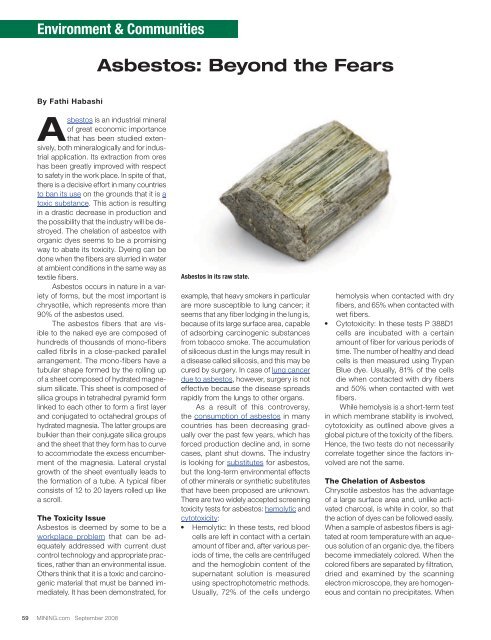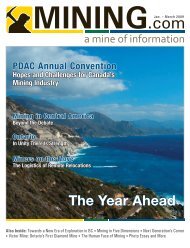You also want an ePaper? Increase the reach of your titles
YUMPU automatically turns print PDFs into web optimized ePapers that Google loves.
Environment & Communities<br />
By Fathi Habashi<br />
Asbestos is an industrial mineral<br />
of great economic importance<br />
that has been studied extensively,<br />
both mineralogically and for industrial<br />
application. Its extraction from ores<br />
has been greatly improved with respect<br />
to safety in the work place. In spite of that,<br />
there is a decisive effort in many countries<br />
to ban its use on the grounds that it is a<br />
toxic substance. This action is resulting<br />
in a drastic decrease in production and<br />
the possibility that the industry will be destroyed.<br />
The chelation of asbestos with<br />
organic dyes seems to be a promising<br />
way to abate its toxicity. Dyeing can be<br />
done when the fibers are slurried in water<br />
at ambient conditions in the same way as<br />
textile fibers.<br />
Asbestos occurs in nature in a variety<br />
of forms, but the most important is<br />
chrysotile, which represents more than<br />
90% of the asbestos used.<br />
The asbestos fibers that are visible<br />
to the naked eye are <strong>com</strong>posed of<br />
hundreds of thousands of mono-fibers<br />
called fibrils in a close-packed parallel<br />
arrangement. The mono-fibers have a<br />
tubular shape formed by the rolling up<br />
of a sheet <strong>com</strong>posed of hydrated magnesium<br />
silicate. This sheet is <strong>com</strong>posed of<br />
silica groups in tetrahedral pyramid form<br />
linked to each other to form a first layer<br />
and conjugated to octahedral groups of<br />
hydrated magnesia. The latter groups are<br />
bulkier than their conjugate silica groups<br />
and the sheet that they form has to curve<br />
to ac<strong>com</strong>modate the excess encumberment<br />
of the magnesia. Lateral crystal<br />
growth of the sheet eventually leads to<br />
the formation of a tube. A typical fiber<br />
consists of 12 to 20 layers rolled up like<br />
a scroll.<br />
The Toxicity <strong>Issue</strong><br />
Asbestos is deemed by some to be a<br />
workplace problem that can be adequately<br />
addressed with current dust<br />
control technology and appropriate practices,<br />
rather than an environmental issue.<br />
Others think that it is a toxic and carcinogenic<br />
material that must be banned immediately.<br />
It has been demonstrated, for<br />
59 <strong>MINING</strong>.<strong>com</strong> September 2008<br />
Asbestos: Beyond the Fears<br />
Asbestos in its raw state.<br />
example, that heavy smokers in particular<br />
are more susceptible to lung cancer; it<br />
seems that any fiber lodging in the lung is,<br />
because of its large surface area, capable<br />
of adsorbing carcinogenic substances<br />
from tobacco smoke. The accumulation<br />
of siliceous dust in the lungs may result in<br />
a disease called silicosis, and this may be<br />
cured by surgery. In case of lung cancer<br />
due to asbestos, however, surgery is not<br />
effective because the disease spreads<br />
rapidly from the lungs to other organs.<br />
As a result of this controversy,<br />
the consumption of asbestos in many<br />
countries has been decreasing gradually<br />
over the past few years, which has<br />
forced production decline and, in some<br />
cases, plant shut downs. The industry<br />
is looking for substitutes for asbestos,<br />
but the long-term environmental effects<br />
of other minerals or synthetic substitutes<br />
that have been proposed are unknown.<br />
There are two widely accepted screening<br />
toxicity tests for asbestos: hemolytic and<br />
cytotoxicity:<br />
Hemolytic: In these tests, red blood<br />
cells are left in contact with a certain<br />
amount of fiber and, after various periods<br />
of time, the cells are centrifuged<br />
and the hemoglobin content of the<br />
supernatant solution is measured<br />
using spectrophotometric methods.<br />
Usually, 72% of the cells undergo<br />
hemolysis when contacted with dry<br />
fibers, and 65% when contacted with<br />
wet fibers.<br />
Cytotoxicity: In these tests P 388D1<br />
cells are incubated with a certain<br />
amount of fiber for various periods of<br />
time. The number of healthy and dead<br />
cells is then measured using Trypan<br />
Blue dye. Usually, 81% of the cells<br />
die when contacted with dry fibers<br />
and 50% when contacted with wet<br />
fibers.<br />
While hemolysis is a short-term test<br />
in which membrane stability is involved,<br />
cytotoxicity as outlined above gives a<br />
global picture of the toxicity of the fibers.<br />
Hence, the two tests do not necessarily<br />
correlate together since the factors involved<br />
are not the same.<br />
The Chelation of Asbestos<br />
Chrysotile asbestos has the advantage<br />
of a large surface area and, unlike activated<br />
charcoal, is white in color, so that<br />
the action of dyes can be followed easily.<br />
When a sample of asbestos fibers is agitated<br />
at room temperature with an aqueous<br />
solution of an organic dye, the fibers<br />
be<strong>com</strong>e immediately colored. When the<br />
colored fibers are separated by filtration,<br />
dried and examined by the scanning<br />
electron microscope, they are homogeneous<br />
and contain no precipitates. When




